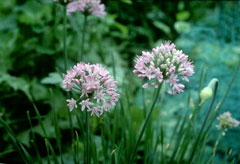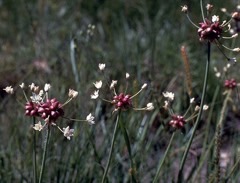 |
|
(c) 2010 Ken Fern, Plants For A Future |
 |
|
Translate this page:
Summary
Physical Characteristics

 Allium canadense is a BULB growing to 0.5 m (1ft 8in) by 0.2 m (0ft 8in).
Allium canadense is a BULB growing to 0.5 m (1ft 8in) by 0.2 m (0ft 8in).
See above for USDA hardiness. It is hardy to UK zone 4 and is not frost tender. It is in flower from May to June. The species is hermaphrodite (has both male and female organs) and is pollinated by Bees, insects.
Suitable for: light (sandy) and medium (loamy) soils. Suitable pH: mildly acid, neutral and basic (mildly alkaline) soils. It can grow in semi-shade (light woodland) or no shade. It prefers moist or wet soil.
UK Hardiness Map
US Hardiness Map
Synonyms
Plant Habitats
Woodland Garden Sunny Edge; Dappled Shade; Bog Garden; Cultivated Beds;
Edible Uses
Edible Parts: Flowers Leaves Root
Edible Uses:
Bulb - raw or cooked[46, 61, 62, 177]. It can be used as a vegetable, or as a flavouring in soups and stews, and can also be pickled[2]. The bulb is up to 30mm in diameter, it is crisp, mild and with a pleasant flavour[183]. Used as a leek substitute according to one report[22], it is a garlic substitute according to others[55, 159, K]. Leaves - raw or cooked[55, 62, 177]. A delicious mild flavour, they are available from early spring until the autumn[K]. They make a very acceptable salad and can also be used as a greens or as a flavouring in cooked foods[K]. Flowers - raw. A little bit stronger flavour than the leaves, especially as the seeds begin to form, they can be used as a flavouring and garnish on salads[K]. Some forms of this species produce bulbils. These top-setting bulbils make a fine onion flavoured pickle[62, 105, 183]. They are said to have a superior flavour to other pickled onions[2].
References More on Edible Uses
Medicinal Uses
Plants For A Future can not take any responsibility for any adverse effects from the use of plants. Always seek advice from a professional before using a plant medicinally.
Antiasthmatic Carminative Cathartic Diuretic Expectorant Stimulant
The plant is antiasthmatic, carminative, cathartic, diuretic, expectorant and stimulant[257]. A tincture is used to prevent worms and colic in children, and also as a remedy for croup[257]. Although no other specific mention of medicinal uses has been seen for this species, members of this genus are in general very healthy additions to the diet. They contain sulphur compounds (which give them their onion flavour) and when added to the diet on a regular basis they help reduce blood cholesterol levels, act as a tonic to the digestive system and also tonify the circulatory system[K].
References More on Medicinal Uses
The Bookshop: Edible Plant Books
Our Latest books on Perennial Plants For Food Forests and Permaculture Gardens in paperback or digital formats.

Edible Tropical Plants
Food Forest Plants for Hotter Conditions: 250+ Plants For Tropical Food Forests & Permaculture Gardens.
More

Edible Temperate Plants
Plants for Your Food Forest: 500 Plants for Temperate Food Forests & Permaculture Gardens.
More

More Books
PFAF have eight books available in paperback and digital formats. Browse the shop for more information.
Shop Now
Other Uses
Repellent
The juice of the plant is used as a moth repellent. The whole plant is said to repel insects and moles[20]. The plant can be rubbed on exposed parts of the body to protect them from insect bites and the bites of scorpions, lizards etc[257].
Special Uses
Food Forest
References More on Other Uses
Cultivation details
Prefers a sunny position in a light well-drained soil[1]. A moisture loving plant according to another report[42]. The bulbs should be planted fairly deeply[1]. Bulbs grow to a good size under cultivation[183]. Some forms of this species produce many bulbils and are considered to be a pernicious weed in some areas of America[159], there is some risk that they could spread aggressively in Britain[203]. A. canadense mobilense. (Reg.)F.M.Ownb. is a form that does not produce bulbils and is much better behaved[200]. Grows well with most plants, especially roses, carrots, beet and chamomile, but it inhibits the growth of legumes[18, 20, 54]. This plant is a bad companion for alfalfa, each species negatively affecting the other[201]. Members of this genus are rarely if ever troubled by browsing deer[233]. For polyculture design as well as the above-ground architecture (form - tree, shrub etc. and size shown above) information on the habit and root pattern is also useful and given here if available. The plant growth habit is a clumper with limited spread [1-2]. The root pattern is a bulb.
References Carbon Farming Information and Carbon Sequestration Information
Temperature Converter
Type a value in the Celsius field to convert the value to Fahrenheit:
Fahrenheit:
The PFAF Bookshop
Plants For A Future have a number of books available in paperback and digital form. Book titles include Edible Plants, Edible Perennials, Edible Trees,Edible Shrubs, Woodland Gardening, and Temperate Food Forest Plants. Our new book is Food Forest Plants For Hotter Conditions (Tropical and Sub-Tropical).
Shop Now
Plant Propagation
Seed - sow spring in a cold frame. Prick out the seedlings into individual pots when they are large enough to handle - if you want to produce clumps more quickly then put three plants in each pot. Grow them on in the greenhouse for at least their first winter and plant them out into their permanent positions in spring once they are growing vigorously and are large enough. Division in spring. Very easy, the plants divide successfully at any time in the growing season and the divisions can be planted straight out into their permanent positions if required. Bulbils planted in situ when ripe.
Other Names
If available other names are mentioned here
Native Range
NORTHERN AMERICA: Canada, Québec, Ontario, New Brunswick, United States, Connecticut, Indiana, Maine, Massachusetts, Michigan, New Hampshire, New Jersey, New York, Ohio, Pennsylvania, Rhode Island, Vermont, West Virginia, Illinois, Iowa, Kansas, Minnesota, Missouri, Nebraska, Oklahoma, South Dakota, Wisconsin, Alabama, Arkansas, Delaware, Florida, Georgia, Kentucky, Louisiana, Maryland, Mississippi, North Carolina, South Carolina, Tennessee, Virginia, District of Columbia, Texas,
Weed Potential
Right plant wrong place. We are currently updating this section.
Please note that a plant may be invasive in one area but may not in your area so it's worth checking.
Possibly a noxious weed in Arkansas (Allium, wild onion, wild garlic): Noxious weed.
Conservation Status
IUCN Red List of Threatened Plants Status : This taxon has not yet been assessed. Other information: Maine
(wild garlic):
Special Concern.
New Hampshire (wild garlic) :Endangered.
Vermont
(wild garlic)
:Threatened.

Growth: S = slow M = medium F = fast. Soil: L = light (sandy) M = medium H = heavy (clay). pH: A = acid N = neutral B = basic (alkaline). Shade: F = full shade S = semi-shade N = no shade. Moisture: D = dry M = Moist We = wet Wa = water.
Now available:
Food Forest Plants for Mediterranean Conditions
350+ Perennial Plants For Mediterranean and Drier Food Forests and Permaculture Gardens.
[Paperback and eBook]
This is the third in Plants For A Future's series of plant guides for food forests tailored to
specific climate zones. Following volumes on temperate and tropical ecosystems, this book focuses
on species suited to Mediterranean conditions—regions with hot, dry summers and cool, wet winters,
often facing the added challenge of climate change.
Read More
Expert comment
Author
L.
Botanical References
43200
Links / References
For a list of references used on this page please go here
Readers comment
| Add a comment |
|
If you have important information about this plant that may help other users please add a comment or link below. Only comments or links that are felt to be directly relevant to a plant will be included. If you think a comment/link or information contained on this page is inaccurate or misleading we would welcome your feedback at [email protected]. If you have questions about a plant please use the Forum on this website as we do not have the resources to answer questions ourselves.
* Please note: the comments by website users are not necessarily those held by PFAF and may give misleading or inaccurate information.
To leave a comment please Register or login here All comments need to be approved so will not appear immediately.
|
Subject : Allium canadense
|
|
|
|